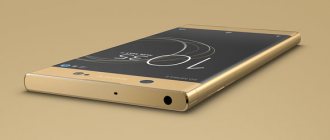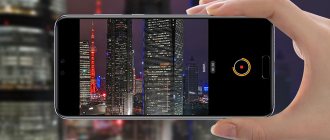Xiaomi is an example of dynamic short-term development, which some call a breakthrough. The Chinese brand began developing phones in 2011, and based on the results of 2021, it came out on top in Russia in the import and sale of smartphones. Reasons for popularity:
- extensive production facilities owned by the company make it possible to reduce the cost of production of spare parts and assembly of finished devices;
- the allocation of funds for a “think tank” of engineers and developers contributes to the release of high-tech new products at a high pace;
- loyalty to distributors and thoughtful marketing policies make Xiaomi smartphones friendly for both buyers and sellers;
- the low price of devices in comparison with competitors allows us to win the “battle” for the user over and over again.
The importance of the camera in Xiaomi smartphones
A gadget maker can improve various components of phones, focusing on long-lasting performance or a powerful processor. The products of the Chinese brand have enough of everything, with close attention paid to cameras.
Smartphone manufacturer Xiaomi pays close attention to improving cameras
The flagships of the Chinese manufacturer are distinguished by record-breaking cameras. But budget devices also show very decent results in terms of shooting quality. It’s no wonder that Xiaomi’s tactics are to release budget devices with impressive characteristics. At the same time, you need to be honest: a smartphone cheaper than 10 thousand rubles will have a good camera, but only in comparison with other budget devices. However, the low price compensates for this feature.
Table No. 1. Purpose of cameras in Xiaomi smartphones.
| Price segment | Camera resolution, MP | Purpose |
| Budget smartphones | From 8 to 13 MP | Amateur photography in the daytime in good lighting |
| Mid-priced devices | From 12 to 64 MP | Universal shooting with customizable parameters, including in the evening |
| Expensive smartphones and flagships | From 20 to 108 MP | Any shooting modes, the ability to create professional photos |
Cameras of the budget Redmi line
The research itself on the topic of budget options is doomed to dull repetition of the same thing. In this case, the manufacturer feels in a Procrustean bed of restrictions; he needs a high-quality product, but at the same time inexpensive. The Xiaomi Redmi model is equipped quite well, but without frills. The camera matrix is from well-known manufacturers Samsung and OmniVision, which occupy a third of the sensor market segment, which in itself is not bad.
The aperture in the cameras remains virtually unchanged, however, the main and front cameras in the new model (starting with Redmi 4) still received more light - f/2.0
The flash doubled after Redmi 3, but optical zoom still didn’t appear. What's nice about the cameras in the budget line is that the phone has become more sophisticated and multifunctional. The storyline attached by the software to the camera is attractive: panorama, geocoordinates in the photo, face recognition and much more. In general, the camera shoots well during the day and, using HDR, at night.
It is characteristic that there was no increase in megapixels. On the contrary, the latest model from the line, Redmi 5, has a camera with fewer light elements, but larger in size. Which gave the photo more sharpness and depth. The 2021 model even sports 4K video. However, this moment is not an achievement of the company, the video shakes during shooting, it’s worth returning to the proven Full HD
Below are photos of all three devices at different times of the day. The modes selected are maximum. That's all the cameras can do.
Redmi3
Redmi4
Redmi 5
The parameters for all models are collected in a table for clarity.
| options | Redmi 3 series | Redmi 4 series | Redmi 5 series | ||
| Main camera | |||||
| Matrix | Samsung S5K3L8 | Samsung S5K3L8 | OmniVision OV12A10 | ||
| Video format | Full HD | Full HD | 4K | ||
| Flash type | LED | Double LED | Double LED | ||
| Stabilization type | Digital | Digital | Digital | ||
| Aperture | f/2.0 | f/2.0 | f/2.2 | ||
| Autofocus type | phase detection autofocus (PDAF) | PDAF | PDAF | ||
| Permission | 13 MP | 13 MP | 12 MP | ||
| Front-camera | |||||
| Matrix | OmniVision OV5670 | OmniVision OV5675 | OmniVision OV5675 | ||
| Video format | Full HD | Full HD | 4K | ||
| Aperture | f/2.2 | f/2.0 | f/2.0 | ||
| Autofocus | Eat | Eat | Eat | ||
How to choose a smartphone with a good camera from Xiaomi
Making a choice in favor of Xiaomi phones means getting a device that is cheaper than that of competing companies, but not inferior to classmates in functionality and advanced hardware. True, the software of Chinese devices may sometimes not work correctly, which is caused by constant updating and modification of released firmware. By paying attention to a number of parameters, you can choose a model according to your taste, requirements and financial capabilities.
Screen diagonal
The trend towards increasing smartphone screen diagonal has gradually stabilized at the same level. What seemed like a portable TV ten years ago is now an average smartphone. However, there is a limit, after which it becomes inconvenient to use a smartphone - it turns into a small tablet, and this is a slightly different device. The diagonal of most modern devices lies within a fairly narrow range from 5 to 6.5 inches.
Most modern smartphones have a screen diagonal of 5 to 6.5 inches
Matrix technology
Today you can find two competing technologies in phones: IPS and AMOLED. They have fallen significantly in price in recent years and are actively installed even on budget-level devices. IPS is cheaper and more reliable, with better color rendition. On the AMOLED side there are deep blacks, an economical mode and fast response time.
Camera
The most important parameter in the current review. Simple devices are equipped with a single camera, but more expensive products have long mastered a system of several optical-electronic modules. The camera in a smartphone cannot be made completely universal - this would require introducing a variable focal length, and this would turn the camera phone into a camera with the ability to communicate through cell towers. Suffice it to recall the example of the Samsung Galaxy S4 Zoom, which remained at the stage of a small-scale model.
Thanks to powerful processors and large amounts of RAM, modern phones are equipped with multiple lenses to take different shots.
The solution was found in installing several lenses with different characteristics. One is suitable for panoramic shooting due to its wide angle, the other is for capturing portraits, and the third is for capturing in macro mode. Sometimes all three or four lenses work together in an HDR scheme, and the resulting images are superimposed on each other to form the final best image. All this became possible thanks to new powerful processors and a large amount of RAM.
CPU
In Xiaomi smartphones you can find two types of multi-core computing systems: Snapdragon and MediaTek. The older the model (the higher the number in the index), the more productive it is, but it also drains the battery faster. Each processor has a large number of fans and opponents, so the user usually chooses a phone based on personal preferences.
RAM
Everything is simple here: the more it is, the better the smartphone will cope with various tasks. True, the amount of memory greatly increases the cost of the device. RAM is also closely related to processor power.
A smartphone with large RAM and a powerful processor will be able to cope better with various tasks.
Built-in memory
Manufacturers realized that using SD cards is not very convenient, and technology has made it possible to create compact and fast memory modules. And if two years ago the standard was 16 Gb, today there are clearly few of them - after all, a significant part is taken up by system files. It is believed that today the minimum comfortable ROM volume should be 64 Gb.
Battery
Experienced users sadly recall the ancient push-button Nokia, which held a charge for a whole week. But the battery capacity was then about 700 mA. Today, 3000 mAh is considered the minimum. Flagship and some mid-range models contain a 4-5 thousand mAh battery for longer operation of a powerful device.
Let's find out what matrix is installed in the Xiaomi phone
To do this, we need to get into the engineering menu; this can be done in two ways.
Or go to general “Settings” , find the “About phone” , there find the “Kernel version” and quickly click on it 8 times.
Or launch the application to dial a phone number and dial:
*#*#6484#*#*
We are in the engineering menu, look for the item “Check version info” . Inside, find the line “Camera information” , under which there will be two values, one for the front camera, the other for the main one. In my case it is imx298 and ov4688 .
But how can you find out the manufacturer using these codes? Copy the name into the Yandex or Google search bar and look at the results; in the first links you will see the name of the manufacturer.
Now you know what photo sensors are installed in the cameras of your Xiaomi or Redmi.
If you are interested, read on the Internet about the technical features of each sensor, its capabilities and user reviews.
Return to content
Voting: which Xiaomi is the best with a good camera?
Which Xiaomi smartphone with a good camera would you choose or recommend?
Xiaomi Mi A2 Lite
3.59 % ( 9 )
Xiaomi Redmi 7
3.19 % ( 8 )
Xiaomi Redmi S2
2.39 % ( 6 )
Xiaomi Redmi Note 2
1.59 % ( 4 )
Xiaomi Redmi Go
0.80 % ( 2 )
Xiaomi Mi 9T
9.56 % ( 24 )
Redmi Note 8 Pro
9.16 % ( 23 )
Xiaomi Redmi Note 8T
7.97 % ( 20 )
Redmi Note 7
2.79 % ( 7 )
Xiaomi Redmi 8
4.78 % ( 12 )
Xiaomi Mi Note 10
25.10 % ( 63 )
Xiaomi Mi CC9 Pro
9.16 % ( 23 )
Xiaomi Mi Mix 3 5G
1.99 % ( 5 )
Xiaomi Pocophone F1
7.97 % ( 20 )
Cameras of the flagship Mi line
The development of top xiaomi models is continuous. The newest developments are constantly announced, Mi7 is already on its way. And if in budget models you can find the entire set of optics manufacturers with whom the company works is more or less constant: Sony, Samsung and OmniVision, then for a flagship smartphone the best of the best camera is selected.
Recently, the manufacturer chosen by the company's management was the Sony concern. The latest top models are equipped with a matrix from it. And it’s not surprising that 40% of the optics market is occupied by this giant, which aspires to world domination. OmniVision is gradually disappearing from the attention of developers; if the flagship Mi5 of last year sported an OV4688 sensor for the front camera, then the Mi6 is already equipped with the best SonyIMX486 at the moment
Mi 5 series
Xiaomi Mi 5 appeared in 2021 and fueled the fading interest in the company. The flagship came out top-end in every sense; special attention was paid to the camera. Continuously working optical stabilization has appeared, as well as a number of additional features, enhanced in subsequent models - 5S, 5SPlus. In 2021, 2 more smartphones from this series appeared - 5C and 5X. To choose which model to choose, a summary table of parameters will help.
| Options | Xiaomi Mi 5 | Xiaomi Mi 5S | Xiaomi Mi 5S+ | Xiaomi Mi 5C | Xiaomi Mi 5X |
| Main camera | |||||
| Permission | 16 MP | 12 MP | 13 MP+13 MP | 12 MP | 12 MP+12 MP |
| Aperture | f/2.0 | f/2.0 | f/2.2 | f/2.2 | f/2.2+f/2.6 |
| Stabilization | OIS+EIS | EIS | EIS | EIS | EIS |
| Autofocus | PDAF | PDAF | PDAF | PDAF | PDAF |
| Matrix | Sony IMX298 Exmor RS | Sony IMX378 Exmor RS | Sony IMX258 Exmor RS | no data | OV12A10 and OV13880 |
| Video Format | 4K | 4K | 4K | 4K | 4K |
| Front-camera | |||||
| Matrix | OV4688 | OV4688 | OV4688 | no data | Samsung S5K5E8 |
| Permission | 4 MP | 4 MP | 4 MP | 8 MP | 5 MP |
| Aperture | f/2.0 | f/2.0 | f/2.0 | f/2.0 | f/2.0 |
| Video format | Full HD | Full HD | Full HD | HD | Full HD |
| Sensor size | 0.25in | 0.25in | 0.25in | no data | 0.14in |
The flagship evolved, and along with it its optical capabilities developed. Mi5 was the first to come out and proved itself more than worthy, especially by providing optical stabilization coupled with electronic stabilization.
It seemed that video shooting would finally stabilize and be able to compete with reference camera phones. But it was not there. The picture during the day turned out blurry and not bright enough. The optical stabilizer could not solve all stabilization problems, and a good matrix turned out to be dull, especially in the dark.
The next 5S already used only electronic stabilization, but the sensor became much more “vigorous” than the previous one. The photos look quite lively and are pleasing to the eye.
The 5S Plus was a step back. Despite the dual camera (the second is monochrome), the effect was rather the opposite; due to the lower aperture (f/2.2), the picture was not pleasing.
Finally, Xiaomi released two more models at the end of the year, one 5C for the Chinese market, there is no data on the matrices of both cameras, and 5X is an attempt to experiment before the launch of a new project - Mi6. But the dual camera from OmniVision with medium aperture did not satisfy the quality.
For comparison, 2 flagships with the best and worst performance were selected. These are Xiaomi Mi 5S and Xiaomi Mi 5C.
The best camera in this line is 5S.
Even in the dark and from a long distance, the clarity and richness of the picture is visible.
The worst camera in the line is the 5C.
The photo is gray and faded and does not stand up to any comparison with the previous one.
Mi 6 series
The series is represented by two models with a difference in output per year – 6 and 6X. A very fresh attempt to surprise the world is Xiaomi Mi 6X, the first sales took place at the end of April 2021 and received rave reviews from all over the world. The smartphone impressed first of all with its video cameras, ahead of its predecessor - Mi6 by a whole body!
The latest development does not have optical stabilization, like the previous version of the flagship, but look at what it is strong at! The dual main camera is impressive. To enhance the effect, a new pixel combining technology has been introduced into the second camera, due to which the size of the light element is almost doubled. In addition, the front camera is able to respond to changes in the external background; the sensor gives the most improved output image. Dual optical zoom nicely complements all the innovations in optics on the flagship.
Example photo of Mi6 with Bokeh effect (blurred background).
There are no reliable photos of Mi6X. Sales have just begun, and the phone has not yet arrived in Russia.
| Options | Mi 6 | Mi 6X |
| Main camera | ||
| matrix | Sony IMX386 Exmor ES | Sony IMX486 Exmor ES+ Sony IMX376 Exmor ES |
| permission | 12 MP+12 MP | 12 MP+20 MP |
| aperture | f/1.8 | f/1.75+ f/1.8 |
| stabilization | OIS+EIS | EIS |
| Front-camera | ||
| matrix | Sony IMX268Exmor ES | Sony IMX376 Exmor ES |
| permission | 8 MP | 20 MP |
| aperture | f/2.0 | f/2.0 |
| Video format | Full HD | Full HD |
Mix Series
Beginning in 2021, frameless phones will hit the market. The very first Mix pretty much amazed Xiaomi fans, but the main thing was yet to come. The evolution of this class of smartphones has followed the path of increasing the power of cameras, this was especially clearly expressed in the transition from Mix 2 to Mix 2S.
From an average photo quality, Xiaomi in the latest version jumped into the sky. The main camera on the Mix 2S is considered one of the best today. Dual optics, vertically positioned, have Dual PDAF optical stabilization, optical zoom, background blur function in portraits and many other “signs” of intelligence. Photos taken at night are surprising in their clarity and bright colors, something that many of the brand’s smartphones previously lacked.
| options | Mix | Mix 2 | Mix 2S |
| Main camera | |||
| Matrix | OmniVision OV16880 | Sony IMX386 Exmor ES | Sony IMX363 Exmor ES |
| permission | 16 MP | 12 MP | 12 MP |
| aperture | f/2.0 | f/2.0 | f/1.8 |
| Stabilization | EIS | EIS | OIS+EIS |
The changes did not affect the front camera, which is average for the class. In all three models it remained unchanged, 5 megapixel resolution and f/2.0 aperture
Sample photos are already available and leaked online, despite sales starting in April 2021.
Max Series
The giant Mi Max has grown to the second version, but nothing significant has been added in terms of optics. In addition, the company did not release a new upgrade in 2018, and the smartphone is still gathering dust on the shelf.
| options | Mi Max | Mi Max2 |
| Main camera | ||
| Matrix | OmniVision OV16880 | Sony IMX386 Exmor ES |
| Permission | 16 MP | 12 MP |
| aperture | f/2.0 | f/2.2 |
| Stabilization | EIS | EIS |
| Front-camera | ||
| Matrix | Samsung S5K5E8 | Samsung S5K5E8 |
| Permission | 5 MP | 5 MP |
| aperture | f/2.0 | f/2.0 |
| Sensor size | 0.14in | 0.14in |
Mi Note series
Xiaomi Note 2, released in 2021, was updated in 2021, the name has not changed, the CE mark has been added. What about cameras? It's not bad, Sony IMX318 Exmor ES with a resolution of 23 megapixels. This is the first time in its history that the company has raised the bar so high. And indeed, looking at the camera’s parameters, we are convinced of its capabilities. There is a hybrid and therefore fast autofocus, a fairly wide viewing angle, an acceptable aperture (f/2), digital zoom and digital stabilization.
Everything seems to be good, but there are also disadvantages...
Too many small pixels are pushed into the matrix and ideal conditions are needed for shooting. The presence of autofocus and digital stabilization does not help the video and it shakes a little when shooting. It can be unpleasant to take pictures in the dark, as “noise” immediately appears, a consequence of the flow of charge from one pixel to another, since there is an overabundance of them here. The camera does not cope well with exposure, often exposing or darkening various parts of the photo at its discretion.
As a result, the camera has more disadvantages than advantages. That is why, following the Note2, the magnificent Xiaomi Note 3 was born. Comparing these two versions is like a battle between David and Goliath, the difference between them is huge.
At the time of the release of the third version of the smartphone, Xiaomi had a win-win option, and the company did not fail to take advantage of it. This is a dual camera from Sony, the pixel size has increased to 1.23 microns (compared to 1 microns for Note2), the aperture reached f/1.8, with optical stabilization and double optical zoom. Which together gave an undeniable result. The new version knocked its short-lived predecessor off its pedestal, and the latest camera's shots shifted priorities. Those who hesitated in choosing between the two versions began to lean in favor of Note3
Model Mi A1
This phone has found its way into flagships only because of its widely advertised dual camera. The optics are notable for the fact that, just like the iPhone 7 camera, it is located horizontally. But that's where the similarities end. The camera sensor is from OmniVision OV12A10, 12 megapixel resolution and f/2.2 aperture, which is not encouraging.
The second sensor is even smaller - f/2.6, from the same manufacturer. The 2x optical zoom inspires some optimism. But the problems of budget cameras remain in full force. This is excessive “noise” and not enough sharpness. Due to the tiny aperture, the user will have to shoot at slow shutter speeds, which is not conducive to quality photography. Stabilization is not stated at all.
Bottom line: there are more problems than necessary, especially for a phone marketed as a flagship.
⇡#Shooting in the interior with a standard viewing angle
This is a noticeably more difficult scene - accurate work with white balance, high-quality detail with good noise reduction and not only a wide dynamic range, but also reliable operation of the optics with numerous sources of artificial light are important here.
| Top row from left to right: Apple iPhone Xs Max, Google Pixel 3 XL; bottom row from left to right: Huawei Mate 20 Pro, Samsung Galaxy S10+, Xiaomi Mi 9 | ||||
| Top row from left to right: Apple iPhone Xs Max, Google Pixel 3 XL; bottom row from left to right: Huawei Mate 20 Pro, Samsung Galaxy S10+, Xiaomi Mi 9 | ||||
In this scene, Huawei's penchant for warm tones works to this smartphone's advantage—colors look natural. The soapiness that we noticed when shooting the street landscape goes away somewhere - the details are clearly defined. Samsung again shows a tendency towards slight overexposure, but provided the dynamic range is good, this does not harm the picture. The colors are cooler than they should be. Xiaomi acts in a very similar way in this story – high-quality work. The iPhone, the colors of which look great on the display of the smartphone itself, on the screen of a calibrated monitor produces a picture that is already too cold, and the difference between the warm bottom and the cold top is pronounced. Pixel is also quite good, but loses to competitors in detail and dynamic range (HDR+ is not included in the work).
- Huawei Mate 20 Pro – 5 points;
- Samsung Galaxy S10+ – 4 points;
- Xiaomi Mi 9 – 3 points;
- Apple iPhone Xs Max – 2 points;
- Google Pixel 3 XL – 1 point.
No miracle happened: powerful and hot
In China, four versions of the phone are sold: the initial two have 8 GB of RAM, the two older ones have 12 GB, and the built-in version can be 128, 256 or 512 GB. There is no slot for a memory card.
In any case, we get the Qualcomm Snapdragon 888 Plus chipset. I was very interested to try the phone in operation - whether the situation has improved compared to devices without Plus or not. But the case still overheats under load and the device is unpleasant to hold in your hands.
A miracle, alas, did not happen; in terms of optimization, the revolution did not happen. And this is sad, because you have to pay for flagship hardware, but in fact you simply cannot use the phone to its fullest. For everyday use, a less powerful filling is sufficient.
⇡#Interior photography with zoom
There are several details here. Three smartphones are equipped with a 2x optical zoom (Xiaomi Mi 9, Samsung Galaxy S10+, iPhone Xs Max), one is equipped with a 3x optical zoom (Huawei Mate 20 Pro), and the Google Pixel 3 XL can only demonstrate its software capabilities with a digital zoom.
| Top row from left to right: Apple iPhone Xs Max, Google Pixel 3 XL; bottom row from left to right: Huawei Mate 20 Pro, Samsung Galaxy S10+, Xiaomi Mi 9 | ||||
| Top row from left to right: Apple iPhone Xs Max, Google Pixel 3 XL; bottom row from left to right: Huawei Mate 20 Pro, Samsung Galaxy S10+, Xiaomi Mi 9 | ||||
And the results are very unexpected. Pixel, with its digital zoom, demonstrates very high-quality work - the image almost does not lose clarity, contour sharpness is neatly adjusted, and there is no “soap”. The picture is just a little dark. The iPhone, however, looks even better: rich but honest colors, good white balance, excellent detail, confident dynamic range. Samsung is not inferior to both in sharpness, but demonstrates a little strange, unnatural color rendition. Xiaomi is slightly inferior in terms of sharpness and exposure accuracy, and the image is pale. Well, Huawei with a three-fold zoom performs the worst in this competition: poor detail combined with poor white balance leave no chance for this creation of Chinese engineering.
- Apple iPhone Xs Max – 5 points;
- Google Pixel 3 XL – 4 points;
- Samsung Galaxy S10+ – 3 points;
- Xiaomi Mi 9 –2 points;
- Huawei Mate 20 Pro – 1 point.
Budget models
Inexpensive Xiaomi smartphones with a battery of 4000 mAh, despite their modest functionality, can boast of at least one feature, for example, Quick Charge technology or a high-resolution camera.
Xiaomi Redmi 9A – anti-blue light screen
The new Xiaomi Redmi 9A is a flagship smartphone with a number of advanced features. The only drawback of the model is its low performance - the previous generation MediaTek Helio G25 processor can hardly cope with demanding games in 2021. But the image quality is excellent - the immersive 6.53-inch screen with HD+ resolution guarantees complete immersion when watching a movie or TV series. Built-in protection technology protects your eyes from harmful blue light.
Autonomy is ensured by a capacious 5000 mAh battery that powers the smartphone in standby mode for up to 35 days.
The main camera is equipped with artificial intelligence. It recognizes gestures, making the photography process even easier. A selfie, for example, can be taken by simply showing your palm.
Redmi 9A is an excellent budget phone for any category of users.
Advantages:
- fits comfortably in the hand due to the rounded edges;
- independent slot for SD storage;
- optimized MIUI 12 shell.
Flaws:
- small amount of RAM;
- outdated Micro-USB charging connector.
Xiaomi Redmi 9C (NFC) – large 6.53-inch display
In the summer of 2021, Xiaomi updated the budget model Redmi 9C, adding an NFC module for making contactless payments. The smartphone is made of hard plastic and is available in three colors: dark grey, orange and blue. The surface of the case is subject to contamination, but there are no traces of hand touch on it.
The main feature of the updated Redmi 9C, in addition to the NFC chip, is a large 6.53-inch immersive display with HD+ resolution. Image transmission technology creates a feeling of complete immersion in the virtual world. The 5000 mAh battery is designed for 1000 charging cycles - the smartphone can be used for 2.5 years without noticeable loss in capacity.
Advantages:
- fast fingerprint scanner;
- high autonomy;
- contactless payments;
- fits nicely in the hand;
- friendly interface of the MIUI 12 system.
Flaws:
- there is no notification indicator;
- Low quality of front camera images.
Xiaomi Redmi 7 – stylish gradient design
Following Redmi 9C, Xiaomi has updated another popular budget smartphone – Redmi 7. The seventh generation is equipped with adequate hardware and has a truly fresh design. The phone has an infinity display with thin frames and a drop-shaped cutout for the front camera. The screen resolution is not high - only 720x1520 pixels, but the overall image quality will be high due to the IPS matrix. The AI-powered dual camera recognizes 27 different scenes to optimize shots in real time.
High performance is achieved thanks to the current generation Qualcomm Snapdragon 632 chipset, equipped with 8 Kryo 250 cores. This combination improves the speed and smoothness of games by 40% compared to previous models.
Advantages:
- large amount of internal and RAM memory;
- infrared port for controlling household appliances;
- possibility of installing two SIM cards with SD storage;
- rich display;
- 2 days of active use without recharging.
Flaws:
- The camera does not shoot well at dusk;
- Incorrect operation of the auto brightness sensor.
Xiaomi Redmi 8A – capacious 5000 mAh battery
Redmi 8A was developed with an emphasis on autonomy - the smartphone is capable of working for 31 days in standby mode. The design will delight lovers of exquisite details, with a choice of 3 elegant colors: midnight black, deep ocean and sunset red. For fast charging, there is a double-sided USB Type-C connector and a 10-watt power supply included. 18-watt units are also supported, fully charging the smartphone in 30 minutes.
The large and bright 6.22-inch display with an optimal 19:9 aspect ratio is covered with Corning Gorilla Glass 5, which protects it from minor impacts. The 12 MP main camera module automatically detects photo scenarios using artificial intelligence. The loud speaker of the Redmi 8A makes it a good option for seniors with hearing loss.
Advantages:
- loud speaker;
- Quick Charge function;
- separate slots for SIM card and SD drive;
- shockproof glass.
Flaws:
- small amount of RAM;
- GPS is slow.











